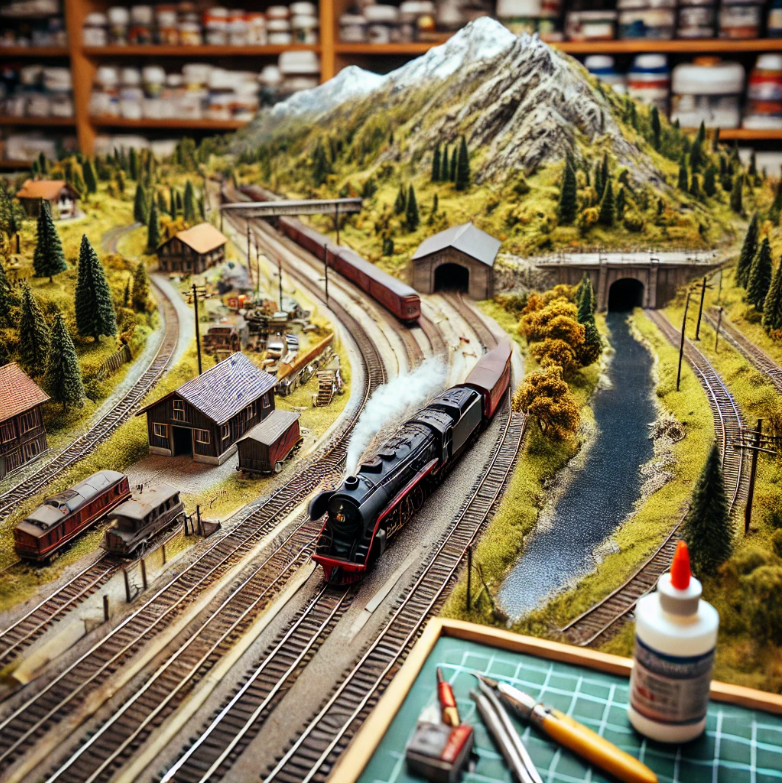Mastering Model Railroad Layout Planning: From Blueprint to Hidden Staging
Planning and staging a model railroad layout is an essential aspect of the hobby that significantly enhances realism, operational efficiency, and the overall enjoyment of running trains. Whether you're a beginner or a seasoned hobbyist, layout planning is a creative yet methodical process that requires balancing space, purpose, and visual appeal. Staging, on the other hand, involves setting up hidden tracks or areas where trains can be prepared for operation without cluttering the visible parts of the layout. Let’s dive into some best practices for layout planning and staging.
Layout Planning: The Blueprint of Your Model Railroad
Planning a model railroad layout requires a thoughtful approach to space, purpose, and the types of scenes you want to create. Here are some core principles to consider:
- Maximizing Space: Whether you have a small corner of a room or an entire basement, effectively utilizing space is critical. Even small layouts can be highly detailed and realistic. For instance, N scale is a popular choice for limited spaces, allowing for complex scenes and extended tracks in confined areas. On the other hand, HO scale remains the most popular for its balance between detail and size.
- Track Plans: A good track plan balances functionality with aesthetics. Track planning should combine operations, construction techniques, and scenic elements to create a layout that not only looks great but is fun to operate. Incorporating elements like loops, spurs, and sidings adds operational variety, while the use of sectional benchwork can offer flexibility and modularity.
- Multi-Era Layouts: Some layouts are designed to represent different time periods. For instance, you might want to switch between running steam locomotives from the 1950s and modern diesel engines. Layouts that are designed with flexibility can accommodate "dual-era" operations, where small changes in structures or scenery help transition the look and feel of the railroad.
- Realism Through Detail: To achieve a high level of realism, modelers often incorporate detailed scenery elements. Using weathering techniques, realistic backdrops, and finely crafted buildings from popular brands, you can elevate the visual appeal of your layout. Don’t underestimate the impact of small details like signage, vehicles, and figures, as these breathe life into your layout.
Staging: Enhancing Operations with Hidden Tracks
Staging is the art of creating hidden areas where trains can be stored, assembled, or prepared for operation without interfering with the visible layout. This is crucial for adding operational realism and flexibility. Here are key tips for staging:
- Deep Staging: One of the latest trends is "deep staging," where trains are held on hidden tracks in a way that allows for dynamic and varied operations. For instance, staging yards, typically placed beneath or behind the main layout, allow you to have multiple trains ready to enter the scene, simulating a busy railroad network. This adds operational complexity and allows for longer and more realistic train movements.
- Hidden Yards: Hidden staging yards can mimic off-layout destinations, such as faraway cities or industrial complexes. A well-designed staging yard can accommodate multiple trains, enabling continuous operation without having to handle or manually replace trains on the tracks.
- Automation and Control: Many modelers are integrating Digital Command Control (DCC) systems with staging yards to automate the movement of trains. These systems can automate train routes, stops, and direction changes, making operations smoother and more realistic. Advanced automation can even involve SCADA systems, which allow for remote control and monitoring of various train movements across your layout.
- Elevated Staging: Another approach is elevated staging, where the staging yard is placed on a different level from the main scene, connected by helixes or ramps. This method allows for more seamless transitions between visible and hidden parts of the layout, reducing the need for manual intervention.
Balancing Aesthetics and Operations
A key aspect of both layout planning and staging is finding a balance between operational complexity and aesthetic appeal. Too much operational detail without proper scenery can detract from the visual experience, while focusing solely on visuals may limit operational possibilities. Successful layouts often merge the two, using staging yards to keep the scenic areas clear while allowing for smooth and realistic train movements.
Layouts that combine deep staging with beautiful scenic designs often hide their complexity behind meticulously detailed backdrops and natural elements, maintaining a sense of realism while enabling flexible and engaging train operations.
Conclusion
Effective layout planning and staging are the cornerstones of a successful and enjoyable model railroad. By blending careful planning with thoughtful staging, you can create a layout that is not only visually stunning but also operationally rich. Whether you're constructing a large, multi-era layout or a compact, detailed scene, the integration of hidden staging yards and advanced control systems will elevate your model railroading experience.
For inspiration and further tips, resources like model railroad planning guides offer a wealth of knowledge from experienced modelers, providing track plans, staging strategies, and construction techniques to bring your model railroad to life.
Find all your model railroad needs at MidwestModelRR.com
Recent Posts
-
Understanding Model Train Wheel Sizes: Why They Matter More Than You Think
When people first get into model railroading, wheel size is rarely top of mind. Track plans
-
Prototype Spotlight: GE ES44AC — Modeling a Modern Freight Workhorse
Prototype Spotlight: GE ES44AC — Modeling a Modern Freight Workhorse Published 2025-09-29• 8–10 min
-
How to Build a Realistic Freight Yard: Flow, Trackwork, and Car Management
How to Build a Realistic Freight Yard: Flow, Trackwork, and Car Management Published 2025-09-25 • 8




